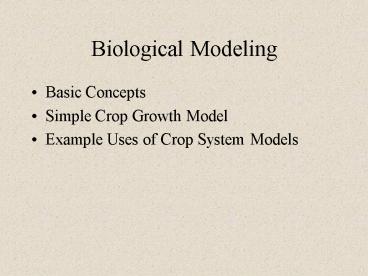Biological Modeling
1 / 40
Title: Biological Modeling
1
Biological Modeling
- Basic Concepts
- Simple Crop Growth Model
- Example Uses of Crop System Models
2
Terminology
- System Collection of Components
- Model Mathematical Representation of System
(Components their Interactions) - State Variables Measures of System that Change
over Time - Simulation Solving a Model, predicting system
behavior over time
3
Systems Approach
Problem Solving
Research
4
A Simple Model
- Rate of Change of N k N
- dNt/dt k Nt
- Solving the model
- Nt1 Nt k Nt
5
BIOLOGICAL MODEL EXAMPLES
- Crop Growth
- Soil Organic Matter
- Microbial Growth
- Insect Populations
- Predator-Prey Populations
- Bio Reactors
- Fish Growth and Reproduction
- Heart Function
- Animal Temperature Regulation
- Eutrophication Processes
- Chemical Transport in Soil, Water
- Food Chain
- Livestock growth
- Plant and Animal Genetics
6
Crop System Models
- Crop growth and yield models have been developed
for various purposes, among others - precision agriculture
- yield forecasting
- irrigation management
- crop sequencing
- nutrient management
- pest management
- land use planning
- climate change assessment
- economic risk
7
Simple Tomato ModelReferenceJ.W. Jones and
J.C. Luyten, 1998. Simulation of biological
processes. Pages 19-62 in R.M. Peart and R.B.
Curry (Eds) Agricultural Systems Modeling and
Simulation.
8
SIMPLE CROP GROWTH MODEL EXAMPLE
Parameters
Parameters
INPUTS
OUTPUTS
MODEL
I0, Light C, CO2 Concentration T, Temperature
N, Nodes Wc, Canopy Weight Wr, Root Weight W,
Total Weight L, Leaf Area Index
9
Rate of Crop Dry Weight Growth
- Photosynthesis minus maintenance respiration
10
Canopy Photosynthesis (1)
- Many different models. We used the Acock et al.
(1978) model. - Pg is a function of light, CO2, temperature and
plant size.
11
Constant LAI4 T30 ºC
12
Constant LAI4 CO2 350
13
Respiration (maintenance)
- Loss of CO2 from plants due to breakdown and
resynthesis of existing tissue
14
Constant CO2 350, Light flux 1200 12 hr
days
15
Constant CO2 350, 12 hr days day/night temp
30/20 ºC
16
A Few Examples of Widely Used Crop Models
17
DSSAT
- Field-Scale Crop Model Application Software
- Biophysical Models (Crop, Soil, Weather), 17
Crops - Risk Analysis (Biophysical and Economic)
- Data Entry and Manipulation Tools
- Utilities (graphics, data entry, management,)
- Crop Rotation Analyzer
- For Use by Researchers
- GIS Products
- GIS-DSSAT Linkage for Region Impact Assessment
- Precision Agriculture Analyzer (GIS)
Developed by IBSNAT Project of USAID, 1983-1993
18
Gainesville, FL 1978
Yield
19
Testing model predictions, Soybean in Georgia
(1987-1996)
20
Application for
Yield Gap Analysis
Peanut - Benin
Biomass (kg/ha)
6,000
Planted Density
5,000
Actual Density (AD)
4,000
AD Fertility (F)
AD F Disease
3,000
Observed
2,000
1,000
0
0
10
20
30
40
50
60
70
80
90
100
Days after Planting
21
Precision Agriculture
- The Problem
- Yield varies considerably within fields
- Spatially varying inputs and management may
increase profits and reduce environmental risks - However
- Understanding what caused yield variability in a
specific field - Determining how to vary management across a field
to optimize profit and meet other goals
22
Genetics
Weather
Crop Models Precision Farming
- Yield
- Soil type
- Images
- Pests
- Elevation
- Drainage
- Fertility
- Causes of Yield Variability
- Develop Prescriptions
- Risk Assessment
- Economics
23
With accurate inputs, crop models can accurately
predict yield
Simulated versus observed maize grain yield, two
years, using field-measured spatially varying
soil parameters in Michigan. R. Braga (2000).
24
Baker Farm (1994) Transect 1
Soybean
W. D. Batchelor et al., 1999 Iowa State University
25
Soybean Crop Yield Variability, Baker Farm (1994)
W. D. Batchelor et al., 1999 Iowa State University
26
Simulated Yields After Estimating Soil Properties
RMSE 74.35 kg/ha
1998 Season Rain 700 mm
1996 Season Rain 418 mm
A. Irmak et al., 2000 University of Florida
27
A. Irmak et al., 2000 University of Florida
28
A. Irmak et al., 2000 University of Florida
29
Crop Models Used in Climate Forecast Applications
for
- Field scale optimal management
- Farm scale, crop mix optimization, considering
risk attitude - Accuracy of climate forecast analysis
- Link with climate models at regional scale
30
Crop Models are Essential Tools
Evaluating models for use in Argentina. On farm
tests in Pampas Region. Magrin et al.
31
Optimizing Planting Date and Nitrogen Fertilizer
Corn Grown in Camilla, GA 45 Years of Weather
(1951-95)
From F. S. Royce
32
C sequestration depends on initial soil C faster
rate early vs. late
Pasture, 25 kg/ha N
Pasture, 25 kg/ha N
33
(No Transcript)
34
(No Transcript)
35
(No Transcript)
36
Putting Biological Models to Use
- Integration with physical, economic, chemical
component models - Data are required
- Conduct Experiments on model to infer behavior of
real system - Research purposes
- Control, Management
- Explore options, provide information for decision
support
37
Research Traditional Approach
38
Incorporating Systems Approach
39
Soybean Yield, kg/ha
Average Yield for Current Conditions
40
Need for Modeling, Systems Approach
- Complex problems, Interdisciplinary Research
Needed - Increased demands for agricultural products
- Increased pressures on natural resources
- Rapid changes in technology, ...
- Globalization of trade, economies
- Information needed for decision making
- Gap between information needed and that created
by disciplinary research - Trial Error approach to agricultural research
is inadequate - Integration of knowledge is essential































